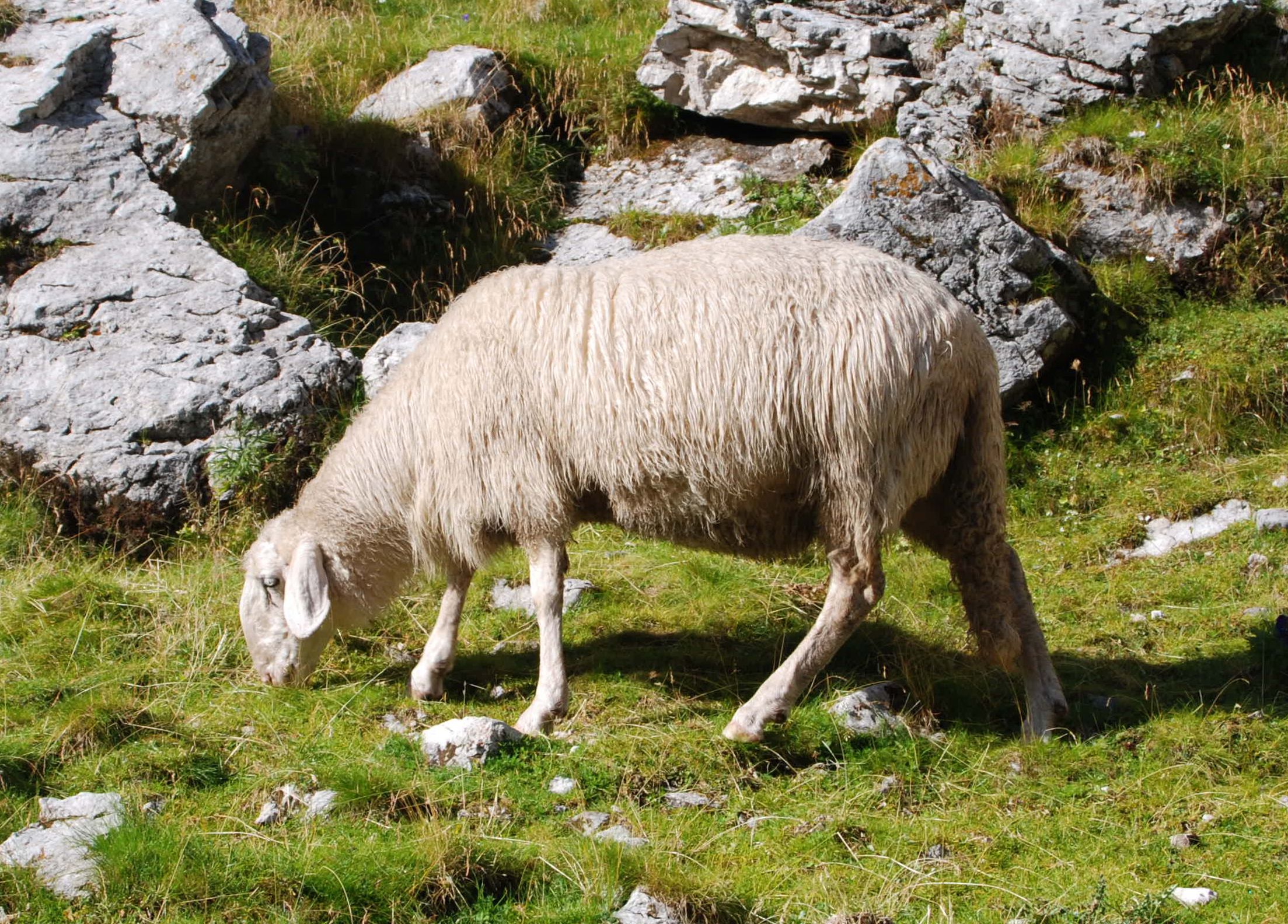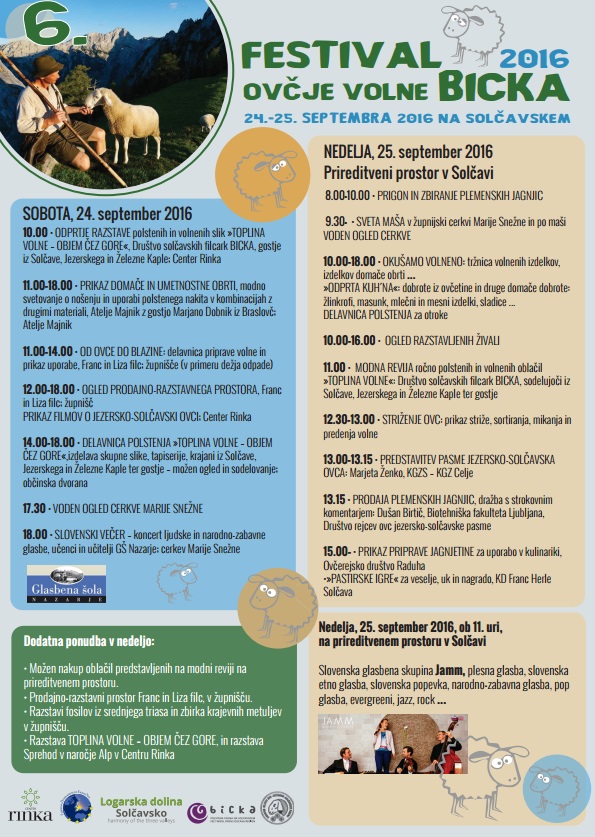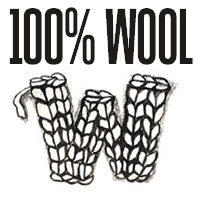Today continuing our EU sheep and wool tour we are in Slovenia where the word for sheep is ovce, and the word for wool is volna.

The two sheep breeds listed as being native to Slovenia are the Jezersko-Solčava breed and the Bovec sheep. The Jezersko-Solčava sheep originate in Jezersko.
ETA: we also learnt from one of our readers that there are two other breeds – the Istrska pramenka and Belokranjska pramenka. Information on the former may be found in Wikipedia and the latter at http://www.drobnica.si/ and we also found this informative pdf using these search terms.

A sheep festival called the Sheep Dance (Ovčji bal) is held in Jezersko annually in mid-August:
The Jezersko-Solcava sheep, an autochthonous sheep breed, is an important part of Slovenian natural and cultural heritage and was named after Jezersko in the north of Slovenia and Solčava in the Upper Savinja valley in the east. There, breeding of these sheep, also called “bicke”, was the most wide-spread and the most organized. Because of its quality, their wool is perfect for a wide range of products. During the winter, spinning wheels and knitting needles were once very commonly used on farms.
At the end of June, herdsmen at Jezersko usually took the sheep to pasture to the mountains, even up to 2,500 meters high, and traditionally their wives sprinkled them with holy water before their departure to wish them a safe journey. The return of the sheep and the herdsmen from the mountain has always been a special experience, the ethnological performance thus being the highlight of events, in which the herdsmen recalled everything that had happened to them in the mountains during the summer. Performances from folk groups and numerous musicians make this even more exciting. You also will not stay hungry as you will be able to try delicious traditional dishes such as masenovka with sour milk, buckwheat porridge with cabbage, and flancati (fried pastry). Everything is prepared according to custom on an open flame, as the herdsmen at Jezersko did it in the past.

There seem to be several of these types of celebratory, regional festivals involving bringing the sheep down from the mountains and wool work demonstrations; this flier is for an event in September in Solčavsko.

The wool of the Jezersko-Solčava sheep is described as being “fine and of good quality”, and the breed originates from cross-breeding the Tiroler Steinschaf with the Italian Bergamasca and Padovana breeds. At the end of 2013 the population reported from Slovenia was 17,200 with smaller numbers of sheep in Austria, Germany and Italy. We found a breed society website that also seems to run workshops for experimenting with the creative possibilities for the wool from these sheep. Their mission statement is as follows:
The purpose of our association is twofold, the conservation of our indigenous sheep, the Jezersko-Solčava breed, and the preservation of the Alpine area, which has had demographic problems. In addition, we are also working towards promoting sheep products (meat, wool), and contributing to the variety of touristic offer.
We are very proud of our unique breed of sheep, which was formed by our ancestors in Jezersko and in the neighboring Solcava farmsteads in earlier centuries. It is renowned and valued for its excellent adaptation to Alpine conditions, and the superb quality of its products.

The Bovec sheep are rarer.
From Wikipedia:
The Bovec sheep (Slovene: bovška ovca, Italian: Plezzana, German: Krainer Steinschaf) is a breed of domestic sheep from the upper valley of the Soča or Isonzo river, now in Slovenia. The breed is named in both Slovenian and in Italian for the town of Bovec or Plezzo; in the Trenta valley it may also be called Trentarka. It is raised in the Soča valley in Slovenia, in the areas of Resia and Tarvisio in Friuli in Italy, and in Styria and Carinthia in Austria. The breed is raised for milk and for meat.
Bovec sheep may be whitish, or in about 30% of cases, black or brown. They have small ears, short, thin legs, and their belly is bare.
The back legs are inclined forward so that they can walk on steep meadows easily.In 2012 a population in Slovenia of 3,500 was reported to DAD-IS. Other sources estimate the number of pure-bred examples there at 1,200. The Krainer Steinschaf population in Austria was reported to be in the range 2,719–4,000 in 2012. The Plezzana is one of the forty-two autochthonous local sheep breeds of limited distribution for which a herdbook is kept by the Associazione Nazionale della Pastorizia, the Italian national association of sheep-breeders; in 2013 the herdbook was empty. The population in Italy is estimated at 40–50 head.
You can see the Bovec sheep breed in this video.
Bovška ovca from Triglavskinarodnipark on Vimeo.
In terms of a living wool industry, there seems to be a lot happening in Slovenia; the Soven wool company are producing a huge range of products in their workshop in Selnica ob Dravi.

From this blog:
They tend to make as many different useful and original wool based products, by which they also help Slovenian sheep-farmers to gain added value for their wool. In the production hangar you’ll see how blankets are made, all sorts of linen, pillows, decorative details, woollen fabrics, rugs and carpets, horse blankets, BIO fabrics, unique knitting, socks, stockings, glows, hats, scarves, pullovers, ponchos, jackets and bed covers. Wool has been used for clothing for millennia. Today the unique wool products have fashion designs and above all warm and natural. But it’s not only people who use wool to keep themselves warm, they also put it into their Bio woollen house insulation. The Soven products are ecologically made. Most are also handmade and have the touch of being *unique,* and because they are made traditionally, they bear a Slovenian *art/craft* certificate.

There is a nice video of the Soven wool shop in Ljubljana here…
…this blog from one of our readers has lots of amazing content about dyeing woollen yarns with plants and mushrooms…
…and this article is filled with hope for the future of Slovenian wool. It outlines a fantastic project – PROJEKT LANATURA – a project which “aims to increase the amount of processed wool and reduce the amount of waste wool.”
The website includes a map where folks in search of wool can find suppliers, and where producers of woollen goods can list what they are making, and is the outcome of a project that has been in operation since 2011 with the following aims:
[PROJEKT LANATURA] is a common Slovenian-Italian initiative for revitalizing the traditional and promoting innovative activities for processing animal materials in the programmed and mainly rural designated area. This objective aims to create conditions in terms of knowledge, experience and the development of new possibilities for the use of animal products (wool, skin, fat) to improve the quality of life in the programming area. By starting these activities we want to recover as much produced animal products from the countryside as possible.
This area still shows a strong connection with the traditional way of farming and supplying of natural, local resources which has a further impact on the natural attractiveness of this area. By enforcing these activities we want to provide knowledge about the usefulness of animal materials for people who live in the program area, expand the range of products and innovations that are respectful of the environment, and utilize them in various crafts and primary agricultural production. In the field of handicraft we believe that more opportunities to work at home might open (making souvenirs, fashion accessories, making natural soaps, etc.). The results of this project will be new products (clothing and fashion accessories, souvenirs, natural additives to improve the earth properties, materials used in bio architecture, etc.) that will be recognized locally and will enrich the tourist attraction areas. Furthermore, an equally important thing will also be the acquired knowledge for less environmental pollution and waste disposal with waste wool.
That is a concept that we at Wovember can 100% get behind!
We hope you have enjoyed this post about Slovenia – as ever please help us to amend any errors and add to the collective knowledge of EU sheep and wool by putting your knowledge in the comments below.
